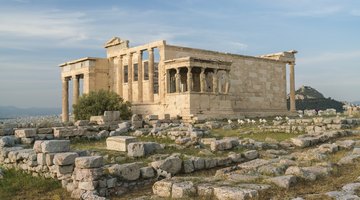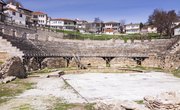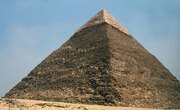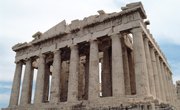The Parthenon, one of the most recognizable landmarks in Greece, has stood on the hill in Athens known as the Acropolis since the fifth century B.C. Much of the structure was destroyed in 1687 when Venice besieged the Turkish-held city, because the Turks used it as a powder magazine. British ambassador Lord Elgin furthered the damage in the early 19th century when he removed a set of beautiful marble friezes; pollution continues to threaten the structure. In its ancient heyday, however, the Parthenon played a key role in Athenian life, as temple, artistic masterpiece and national symbol.
Description
The Parthenon’s design is peripteral, meaning it takes the form of a rectangle with a single row of columns on all sides. The columns are Doric, the simplest form of ancient Greek column; eight stand along each end of the building, with 17 down the longer sides. It surmounts a large flat platform with three steps, and it initially included two inner chambers.
Temple
The main purpose of the Parthenon was as a temple for Athena, virgin goddess and patron of Athens. The building’s very name means “the virgin’s place” in Greek, according to the Columbia Encyclopedia. The United Nations Educational, Scientific and Cultural Organization, designating the Acropolis as a World Heritage Center, calls the hill itself “sacred.” The temple initially kept a colossal, ivory-and-gold statue of Athena; Reed College’s study guide describes it as a “cult statue,” or object of veneration. Behind the large temple chamber, a second, smaller room housed a treasury, where donations and tithes were stored and counted. Every four years, Athenians held a procession to honor the goddess; the Parthenon’s friezes depict one.
Artistry
Even today, in its partially ruined state, architects consider the Parthenon to be one of the finest expressions of Athenian aesthetic proportions, architectural precision and unity of natural setting with design, according to UNESCO. Although the statue of Athena that once dominated the interior has not survived, many other carvings from the building’s walls and friezes demonstrate the height of classical artistry. Museums in eight countries, including Greece and Great Britain, have pieces of sculpture from the Parthenon.
Symbol
Perhaps the most important function of the Parthenon in its early years was neither aesthetic nor wholly religious, however; a brainchild of the great Athenian statesman Pericles, the structure symbolizes the city itself at what Reed College’s study guide calls “the height of its power.” Having concluded the Persian wars, Athens had become, by 447 B.C., the dominant power in what is now Greece, the center of a regional empire. Funds from the other city-states in the Delian League, initially formed to fight Persia, were used to build it. The Acropolis had initially housed kings in Athens’ earliest history, so the site resonated with temporal authority, making the choice to construct a temple to the city’s patroness especially significant in terms of the message such a site and such a building sent to Athens’ citizens, and to the city’s rivals.
Related Articles
References
Resources
Writer Bio
Jennifer Spirko has been writing professionally for more than 20 years, starting at "The Knoxville Journal." She has written for "MetroPulse," "Maryville-Alcoa Daily Times" and "Some" monthly. She has taught writing at North Carolina State University and the University of Tennessee. Spirko holds a Master of Arts from the Shakespeare Institute, Stratford-on-Avon, England.











